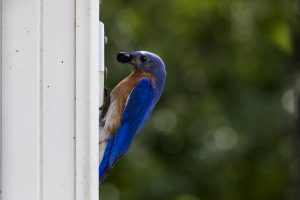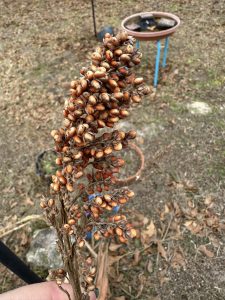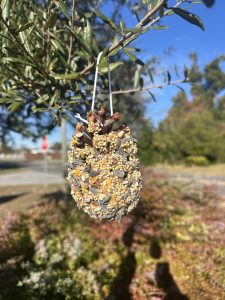Last month, we experienced historic snowfall throughout the Panhandle. During these magical snow days, I noticed that I had to refill my bird feeder faster than expected. Even as snow fell, birds flocked to the feeder all day long.
In winter, birds rely more on bird feeders because many plants are dormant and aren’t producing food. Insects are also less abundant during the colder months. (Read about where they go here: Where Do Insects Go in the Winter?). Growing native plants in your landscape can help provide extra food sources for birds and habitat for overwintering insects. However, long periods of freezing temperatures, like those we experienced last month and in December of 2022, can damage natural food sources and make it even harder for birds to find food.
Consider supporting your local and migrating bird populations this winter by putting out a bird feeder. In return, expect a colorful show you can enjoy in your own yard! Here are some recommendations for success:
- Different birds are attracted to different types of food and have different feeding habits. To reduce mess, look for seed mixes that don’t contain milo, oats, and red millet, often labeled “no mess”. These seeds are less desirable to birds and often end up scattered on the ground, which can attract rodents. Uneaten millet seeds can sprout and grow under bird feeders.
- Suet is an excellent choice for winter feeding because it’s a high-protein, high-energy food source for birds. You can buy suet at the store or make your own using this recipe: DIY Suet Recipe. Another fun, homemade option is the classic pinecone bird feeder made with peanut butter or lard. This kid-friendly activity can be found here: Pinecone Bird Feeder
- It’s important to clean your feeders every two to three weeks to prevent the spread of diseases, get rid of moldy seeds, and keep the birds healthy. Most bird feeders can be cleaned with a 10% bleach solution, while wooden feeders are best cleaned with hot, soapy water. Sugar water in hummingbird feeders should be changed every 3-5 days or more frequently if they’re in direct sunlight or hot weather. Don’t forget to wash your hands after cleaning or refilling your bird feeder!
The best way to support your local birds is by planting native plants and providing a safe habitat in your yard. Native plants produce food and attract insects that birds feed on, helping them thrive year-round. When food is scarce, bird feeders can be an important supplement, but regular cleaning is essential to maintain bird health.
For more detailed information on feeder selection, food types, and tips, visit: Bird Feeder Guide.
- Land, Water, and Lawns: Why Everyday Choices Matter - December 4, 2025
- Let’s Scout the Garden - October 23, 2025
- Non-GMO Seeds at the Garden Center? They All Are! - September 25, 2025



